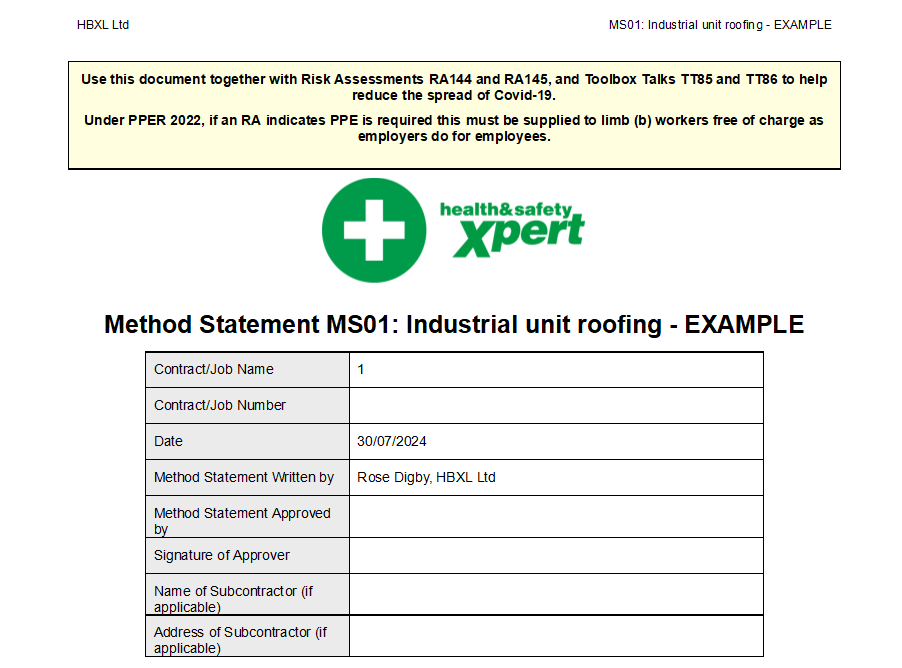You’re flat out with work, let alone have free time to deal with paperwork. But when it comes to UK Health & Safety documents, there's no cutting corners. Getting these essentials in place isn’t just about keeping the site inspectors happy—it’s about making sure everyone goes home safe at the end of the day.
Discover UK Health & Safety documents for builders in 2024 that will give your business the best start at being covered:
1. Risk Assessments
First up, we've got Risk Assessments. These are your go-to UK Health & Safety documents for identifying potential dangers on-site. Whether you're building an extension or just fixing up a roof, you need to think ahead about what could go wrong and how to prevent it. Make sure you cover all the bases and keep it updated, especially if the job scope changes. Detailed assessments identifying potential hazards and risks include:
Site-specific risk assessments
Task-specific risk assessments
Control measures to mitigate risks
Watch this short video, where we show you how you can review, edit, create, export and print Risk Assessments in Health & Safety Xpert here.
Check out and download our free Risk Assessment here.
2. Method Statements
Next on the UK Health & Safety documents list are Method Statements. These are basically your game plan for getting the job done safely. It’s not just about the “what,” but the “how.” Include details like the equipment you’ll use, the safety gear required, and the steps to follow. It’s like giving your team a map—everyone knows the route and the hazards to avoid. Detailed Health & Safety documents for builders outline how specific tasks will be carried out safely, including:
Work procedures
Required equipment
Safety measures and precautions
Watch this short tutorial about when you should use a Method Statement and how to create one using Health & Safety Xpert here.
Check out and download our free method statement here.
3. COSHH Assessments
If you're dealing with any substances that could be harmful, you'll need COSHH Assessments (Control of Substances Hazardous to Health). This UK Health & Safety document isn't just for the obvious stuff like chemicals—paints and cleaning products count too. Make sure you outline how to use these materials safely and what to do if something goes pear-shaped. With stricter regulations coming in, keeping these assessments up-to-date is more important than ever. Control of Substances Hazardous to Health (COSHH) assessments for hazardous substances, including:
Identification of hazardous substances
Risk assessments
Control measures
Watch this short tutorial where we show you how to review, edit, create, export and print COSHH Assessments in Health & Safety Xpert here.
4. Accident Report Forms
Let's face it, accidents can happen even on the best-run sites. That’s why you need Accident Report Forms. These UK Health & Safety documents are crucial for documenting any incidents, big or small. They’re not just for covering your back if something goes wrong; they’re also a tool for learning and improving your Health & Safety awareness. Keep these forms handy and ensure everyone knows how to use them. And remember, confidentiality is key. Documentation of any accidents, incidents, or near misses, including:
Date and time of occurrence
Details of the incident
Investigations and corrective actions
5. Site Induction Records
Starting a new project? Don’t forget the Site Induction Records in your UK Health & Safety documents. Every person who sets foot on your site needs a proper induction. This isn’t just a quick chat; it’s about making sure everyone knows the site layout, the emergency procedures, and the safety rules. Record these inductions—it’s not just about ticking boxes; it's about making sure your Health and Safety for builders is correct. Documents recording the induction of workers and visitors, including:
Site-specific safety rules
Emergency procedures
Introduction to site layout and welfare facilities
6. PPE Register
Personal Protective Equipment (PPE) is a must on any site, and having a PPE Register helps you keep track of what’s issued and to who. This UK Health & Safety document should list the PPE provided, when it was given out, and when it needs replacing. This not only ensures everyone has the right gear but also helps you manage your stock and budget. Plus, it shows you're serious about keeping your team safe. Records of PPE issued to workers, including:
Type of equipment provided
Date of issue
Maintenance and replacement schedules
7. Health and Safety Policy
Last but definitely not least, make sure you've got a solid Health and Safety Policy. This is your company's commitment to Health & Safety for your builders. It should outline how you manage risks, the training provided, and who’s responsible for what. Even if you’re running a small crew, having this in writing can save you a lot of headaches and show clients you mean business. A document outlining the company's commitment to UK health and safety, including:
General statement of intent
Responsibilities for health and safety
Arrangements for managing health and safety
Watch this short tutorial how to edit the Health & Safety Policy in Health & Safety Xpert to suit your company. We also demonstrate how to print and export the Health & Safety Policy here.
Wrapping It Up and Giving it a Try
So, there you go—the essential UK Health & Safety documents in 2024. I know it might feel like just more paperwork, but these documents are vital. They’re not only about compliance but also about creating a safe and efficient working environment.
Take some time to get these documents sorted and consider using construction software like Health & Safety Xpert to help manage it all.
Give Health & Safety Xpert a try for free today.
To find out more give our Getting Started: Health & Safety videos a watch.
If you don’t have Health & Safety Xpert, call our support team at 0117 916 7898 or take a look at the software in more detail here.








